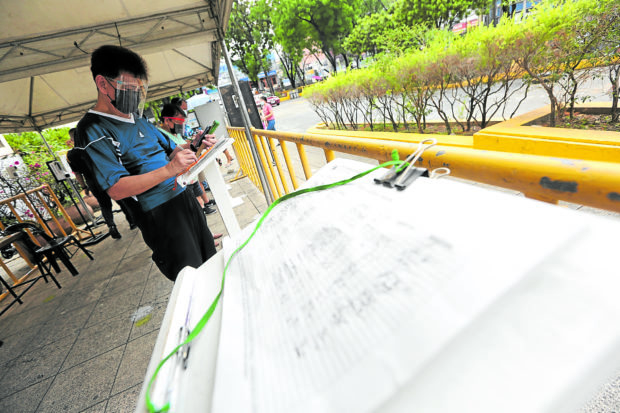Populous barangays hit by high COVID-19 cases – Popcom

TRACKING MEASURE As part of COVID-19 tracking measures, people fill out contact tracing forms before they are allowed inside the Sto. Domingo Church in Quezon City on Sunday. —NIÑO JESUS ORBETA
MANILA, Philippines — Nearly 1,300 barangays in the country grappled with the pandemic situation with high COVID-19 caseloads from September last year to April 15, according to the government’s lead agency on population management.
The Commission on Population and Development (Popcom) said each of the 1,272 densely populated barangays had an average of 137 COVID-19 cases throughout the period, well beyond the low-end figure of 19 reported in 20,889 other barangays.
There are 42,300 barangays nationwide.
Popcom said 15,252 barangays did not report any COVID-19 case during the same period.
It described the troubled areas as very densely populated, with number of people ranging from 201 to 999 per hectare, or well above the ideal density of 200.
On the other hand, those with lower caseloads have relatively fewer people, with population density below 200 per ha.
Vulnerabilities tool
Popcom released the findings of its demographics vulnerabilities tool or DVT on Sunday on its website popcom.gov.ph. The DVT is an instrument to monitor the spread of coronavirus disease in communities.
On Sunday, the Department of Health (DOH) recorded 3,083 newly confirmed COVID-19 cases, pushing the total to 1,179,812. But it was quick to add that the number of new cases was relatively low due to ongoing updates in the recording system, COVIDKaya, as certain data was not included in the case bulletin.
The DOH registered 38 more deaths, including 25 who were previously tagged as recoveries. This brought the death toll to 19,951.
There were 6,756 more recoveries under the DOH’s two-week quarantine recovery protocol, raising total number of survivors to 1,109,226.
The country still has 50,635 active cases, of which 93.1 percent are mild, 2.1 percent asymptomatic, 1.35 percent moderate, 2 percent severe and 1.5 percent critical.
Three testing laboratories did not submit data.
More Popcom findings
According to Popcom, 63 percent of barangays nationwide reported COVID-19 infections from September last year to April this year. Eleven percent reported deaths due to the disease.
Densely populated barangays reported an average of 3.38 deaths. The less densely populated ones tallied an average of 1.84, but Popcom Executive Director Juan Antonio Perez III said this was a “higher-than-expected” death rate that did not commensurate with the number of cases.
This is due to the lack of access to health-care facilities, Perez said. “We can say that the lack of medical workers, as well as geographic limitations, pose impediments to their required level of medical care,” he said.
Popcom reported that in Metro Manila and nearby Cavite, Laguna, Rizal and Bulacan provinces, which comprised the epicenter of the surge from March to early May, densely populated barangays accounted for 25 percent of the reported COVID-19 deaths while less densely populated barangays accounted for 53 percent.
Perez said he hoped local governments would use the latest report of the DVT for their pandemic mitigation efforts since it identified the barangays where health protocols and contact tracing should be strictly implemented.
It can also be used as basis for vaccination rollouts according to geographic priorities, he said.
For more news about the novel coronavirus click here.
What you need to know about Coronavirus.
For more information on COVID-19, call the DOH Hotline: (02) 86517800 local 1149/1150.
The Inquirer Foundation supports our healthcare frontliners and is still accepting cash donations to be deposited at Banco de Oro (BDO) current account #007960018860 or donate through PayMaya using this link.